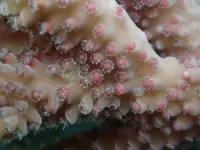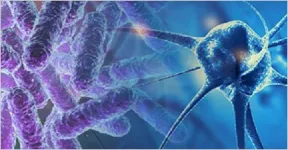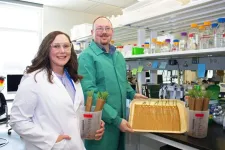(Press-News.org)
Corals play an essential role in ocean ecosystems, and like many organisms, they are under threat from climate change and other human activities. To better protect coral, it’s first necessary to understand them, in particular their reproductive life cycle, which only happens once a year. For the first time, researchers have produced a model for coral spawning, based on various environmental factors. They achieved this by tapping an often overlooked source of aquatic knowledge, an aquarium.
Given their branching shapes or waving tendrils, you would be forgiven for thinking of coral as the trees of the sea. But they are really colonies of small anemones, some of which form sturdy structures which are often the familiar shapes we see in reefs. As they are not plants, they don’t reproduce using seeds, but actually reproduce as animals do, with eggs and sperm. The way they do this, though, is mysterious and rare to see.
“Coral mass spawning, where corals release their eggs and sperm in synchronized bundles over several days following a full moon, is one of the most spectacular reproduction events in the world,” said Associate Professor Shinichiro Maruyama from the Department of Integrated Biosciences at the University of Tokyo. “However, despite decades of studies, environmental drivers of the synchronous spawning remain unclear. Coral spawning data are very sparse; it’s usually only an annual event. Putting such sparse data into a model that can explain the overall pattern of spawning has been impossible, but we’ve finally found a way that works.”
To study coral spawning in situ would be theoretically possible, but practically problematic. Researchers would need to install various types of robust environmental sensors around coral beds and dive daily to make observations. This is expensive, impractical and risky, especially at night and in bad weather. Maruyama and his team sought an alternative scenario and found one in the form of an aquarium, specifically the Okinawa Churaumi Aquarium.
“The Okinawa Churaumi Aquarium had kept 15 years of coral spawning records for Acropora corals, a reef building coral commonly found in Japan’s southernmost prefecture Okinawa, but this data had not been used for this kind of research before,” said Maruyama. “By collecting, interpreting and interrogating this data, we found that corals use multiple environmental inputs, like like rainfall, solar radiation, and water temperature, to adjust their spawning timing and synchronize it to achieve a peak time for spawning. Water temperature seems to be the primary trigger to determine the annual window of opportunity.”
This study leads to potential applications, such as more accurate coral spawning prediction and assessment of environmental changes that may affect coral reproduction. Understanding coral reproduction activities is crucial for maintaining coral reef ecosystems and protecting related marine life. But if aquariums can provide precious data that researchers cannot easily obtain through experiments and observations, why has this not been explored before?
“Aquariums are treasure troves of research resources with a wealth of untouched and valuable data. On the other hand, some scientists tend to think that they don’t truly reflect nature, and also that they are not as well organized as a laboratory. We were fascinated by that gap in recognition and the possibilities that had been hidden, overlooked and sometimes neglected,” said Maruyama. “Here, we analyzed past data to make a model that fits that data. Next, we plan to produce a mathematical model to predict future spawning events in nature.”
###
Journal article:
Yusuke Sakai, Hiromi H. Yamamoto, Shinichiro Maruyama. “Long-term aquarium records delineate the synchronized spawning strategy of Acropora corals”, Royal Society Open Science
Funding:
This work was supported by JSPS KAKENHI Grant Numbers JP20J01841 (to Y.S.), JP19K06786, JP22H02697 (to S.M.). Y.S. is supported by Grant-in-Aid for JSPS Fellows.
Research contact:
Professor Shinichiro Maruyama
Department of Integrated Biosciences, Graduate School of Frontier Sciences
The University of Tokyo, 5-1-5 Kashiwanoha, Kashiwa, Chiba 277-0882, Japan
shinichiro.maruyama@k.u-tokyo.ac.jp
Department of Integrated Biosciences
https://www.ib.k.u-tokyo.ac.jp/english/
Graduate School of Frontier Sciences
https://www.k.u-tokyo.ac.jp/en/index.html
Press contact:
Mr. Rohan Mehra
Public Relations Group, The University of Tokyo,
7-3-1 Hongo, Bunkyo-ku, Tokyo, 113-8656, Japan
press-releases.adm@gs.mail.u-tokyo.ac.jp
About The University of Tokyo:
The University of Tokyo is Japan's leading university and one of the world's top research universities. The vast research output of some 6,000 researchers is published in the world's top journals across the arts and sciences. Our vibrant student body of around 15,000 undergraduate and 15,000 graduate students includes over 4,000 international students. Find out more at www.u-tokyo.ac.jp/en/ or follow us on X (formerly Twitter) at @UTokyo_News_en.
END
Research led by the University of Plymouth has shown that a new deep learning AI model can identify what happens and when during embryonic development, from video.
Published today (Wednesday 29 May) in the Journal of Experimental Biology, the study highlights how the model, known as Dev-ResNet, can identify the occurrence of key functional developmental events in pond snails, including heart function, crawling, hatching and even death.
A key innovation in this study is the use of a 3D model that uses changes occurring between frames of the video, and enables the AI to learn from these features, as opposed to the more traditional use of still images.
The ...
Primates, including humans, have larger brains than most other mammals, but why? Scientists searching for the answer have long followed a trail pointing to diet—specifically fruit—as the reason for why primates evolved larger brains. A team from the Max Planck Institute of Animal Behavior and the Smithsonian Institute of Tropical Research tested this idea for the first time—finding that the fruit-diet theory might be out of juice. The researchers used drone imaging, GPS tracking, and fine-scale behavioral analyses to test how four species of fruit-eating mammals solved the same natural foraging puzzle in a Panamanian rainforest. They ...
A new paper published in The Quarterly Review of Biology examines the question of what Darwinism is and how its nonscientific uses relate to the scientific theory of evolution.
Charles Darwin published On the Origin of Species in 1859 as a work in biology. However, in the past century and a half, Darwin’s ideas have impacted a broad range of domains and stimulated scientists and scholars to advance "evolutionary approaches" in domains as diverse as economics, engineering, psychology, and history. The ideas have been used (and abused) to undermine religiously inspired ideas about the origin of humans and their status concerning other species, ...
AUSTIN, Texas — Wifi-enabled washing machines. Voice-controlled microwaves. App-enabled TVs, vacuum cleaners, and even window blinds you can control from the comfort of your couch.
Many of the technological features now included in everyday products are useful and accessible. But research has shown that having too many can overwhelm potential buyers, making them less likely to make a purchase.
In new research, Wayne Hoyer, marketing professor and James L. Bayless/William S. Farrish Fund Chair for Free Enterprise at Texas McCombs, digs into the phenomenon of “feature creep” and its impact on consumer sentiment. ...
A new study by researchers from Arizona State University and their colleagues highlights a dietary strategy for significant health improvement and weight management.
Participants following an intermittent fasting and protein-pacing regimen, which involves evenly spaced protein intake throughout the day, saw better gut health, weight loss and metabolic responses. These benefits were notably greater than those seen with simple calorie restriction.
The findings, reported today in the journal Nature ...
AMES, Iowa – A widely found gene in plants has been newly identified as a key transporter of a hormone that influences the size of corn. The discovery offers plant breeders a new tool to develop desirable dwarf varieties that could enhance the crop’s resilience and profitability.
A team of scientists led by Iowa State University spent years working to pinpoint the functions of the gene ZmPILS6. Now, they have been able to characterize it as an important driver of plant size and architecture, a carrier for an auxin hormone that helps govern growth in roots below ground and shoots, or stalks, above ground. Their findings were published in the Proceedings ...
Many primary care clinicians directly receive messages from patients via electronic health records’ portal inboxes. The COVID-19 pandemic saw a rapid uptick in this trend. Data suggests that this additional work is linked to clinician burnout. Penn Family Care, a primary care group at Penn Medicine, instead routed incoming messages to certified medical assistants who had been taught how to distribute each message to the most appropriate physician. There was a 40% decrease in the number of messages going directly to primary care physicians, and both practice and clinician efficiency showed improvement after adopting this team-based care model.
Utilizing Medical Assistants ...
Background and Goal: Relational continuity, the ongoing relationship between a patient and a family physician, is linked to better patient care, fewer unnecessary procedures, hospitalizations, emergency department visits, and lower costs, along with higher patient satisfaction. With the rise of part-time practices, patients often see multiple family physicians within the same clinic. This study aimed to explore how continuity in a primary care clinic—separate from individual physician continuity—affects patient ...
Background: Currently, people of Latiné/e/x/o/a, Hispanic, and/or Spanish (LHS) origin make up 19.1% of the population of the U.S. There is great variation in the personal experiences and family backgrounds of LHS individuals, including differences in country of origin, time in the U.S., colonization histories and immigration experiences.
Key Argument: This essay considers the importance of recognizing the heterogeneity of lived experiences among LHS populations in the U.S. in a health care context.
Why ...
Background and Goal: Family physicians perform a wide range of procedures outside the hospital and tend to be office based. Examples may include surgical procedures such as excisions, suturing, and joint injections. Since the training can vary substantially, the Council of Academic Family Medicine (CAFM) issued a statement on which procedures they recommend physicians be able to perform competently upon completion of a family medicine residency. The aim of this study was to determine the extent to which family physicians perform CAFM-recommended procedures for Medicare Part B, the outpatient portion ...






